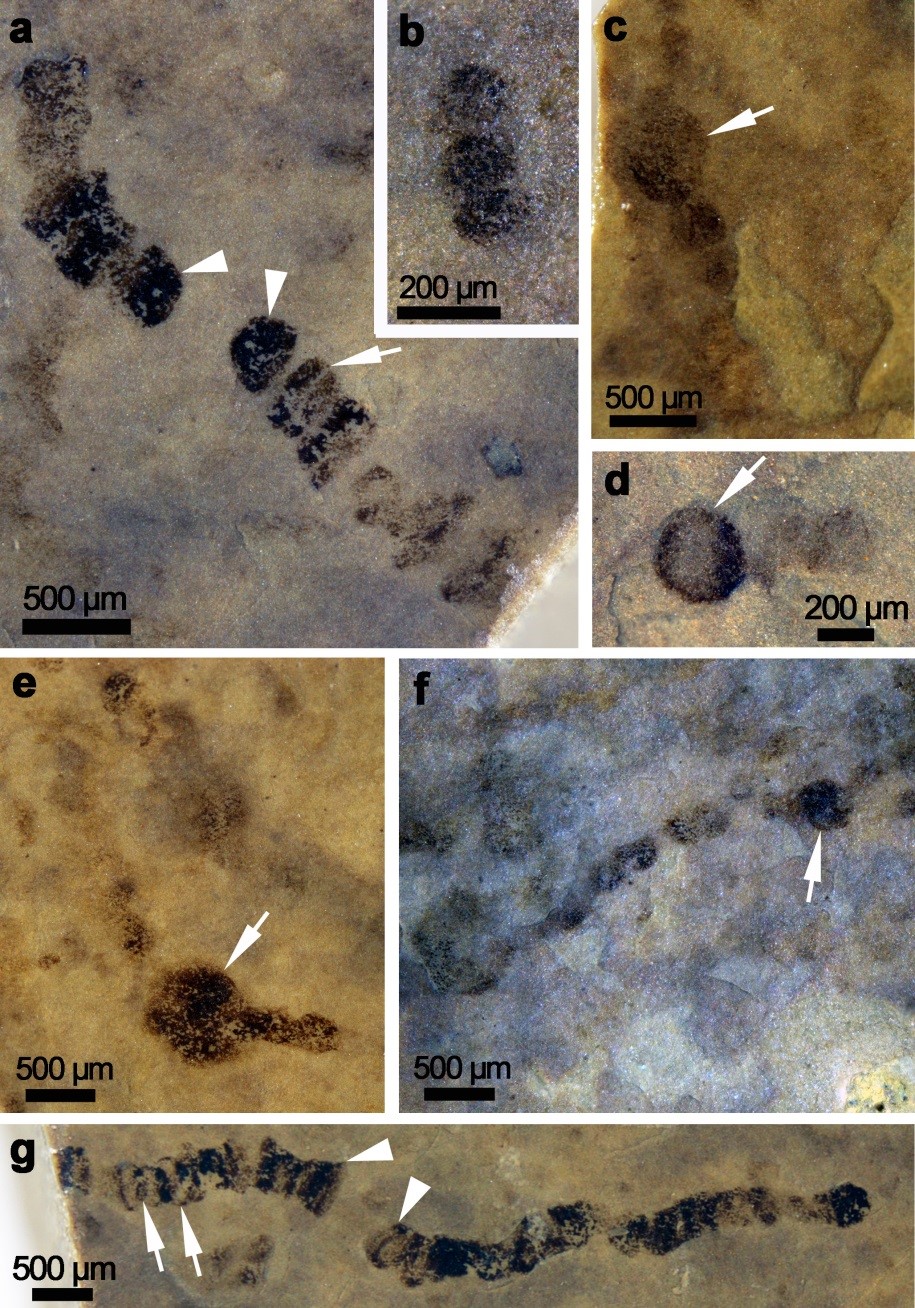For much of the earth history, cyanobacteria were the only source of biogenic oxygen and a major source of fixed carbon and nitrogen. However, it is still not clear when cyanobacteria began to fix nitrogen. The finding of new filamentous cyanobacterial fossil from ca. 1000–720 million-year-old rocks in North China has brought dawn for the tracking of the first nitrogen-fixing cyanobacteria. The results were published in Current Biology with the title "Nitrogen-fixing heterocystous cyanobacteria in the Tonian Period".

Hormogonia, paired cells, and akinetes of Anhuithrix magna. ( Image by PANG Ke)
The origin of cyanobacteria had profound and transformative impacts on carbon, nitrogen, and oxygen cycles in the Earth system. Not only are cyanobacteria (and their evolutionary descendants, plastids) the only oxygenic photosynthesizers, many of them have also acquired the capability of fixing dinitrogen and one clade (including subsections IV and V, i.e., Nostocales and Stigonematales) has developed complex multicellularity with specialized nitrogen-fixing (or diazotrophic) cells known as heterocysts and resting cysts known as akinetes. But when this evolutionary innovation occurred is unknown. Molecular clock estimates of the divergence time of this clade are highly variable, ranging from ~2000 Ma to ~500 Ma. The older estimates are invariably calibrated by putative akinete fossils (described as Archaeoellipsoides) from Paleoproterozoic-Mesoproterozoic rocks around 2100–1400 Ma.
The fossil record of heterocystous cyanobacteria is scarce and disputed. Most reported heterocyst and akinete fossils from Precambrian rocks are probably diagenetic or taphonomic artifacts. One of them, Archaeoellipsoides from ~2100–1400 Ma rocks, was once widely accepted as an akinete fossil, but this interpretation has been recently challenged because of the lack of associated cellular trichomes or extracellular sheath. Thus far, the earliest uncontested fossil record of heterocysts and akinetes comes from the early Devonian (~410 Ma) Rhynie Chert. The scarcity of heterocystous cyanobacterial fossils significantly hampers our understanding of the evolution of complex multicellularity and cell differentiation among cyanobacteria and their role in regulating the carbon, nitrogen, and oxygen cycles in the geological past, and our ability to calibrate cyanobacterial molecular clocks.
A team of scientists led by Dr. PANG Ke from Nanjing Institute of Geology and Palaeontology, Chinese Academy of Sciences and Mr. TANG Qing from Virginia Tech collected hundreds of specimens from a fossiliferous horizon in the Tonian Liulaobei Formation in Shouxian, Anhui Province, China. The new fossil was a mat-forming, filamentous, multicellular cyanobacterium that grew by binary cell division, reproduced by fragmentation, weathered adverse conditions by akinetes, and likely fixed nitrogen in specialized heterocysts.
Anhuithrix magna represents a compelling record of akinete-forming and implicitly heterocystous and diazotrophic cyanobacteria, and attests to the evolution of cellular differentiation among multicellular cyanobacteria in the Tonian Period. As an akinete-bearing cyanobacterium, it provides a minimum age estimate of the divergence of subsections IV+V, challenges molecular clock estimates that place this divergence at ~500 Ma, and and places a firm constraint on the evolution of akinetes and heterocysts. Because nitrogenase (an enzyme responsible for catalyzing nitrogen fixation) is irreversibly inactivated by the presence of free oxygen, the evolution of heterocysts may be an evolutionary response to provide a physical shelter for nitrogenase as pO2 rose to levels that can inhibit the activity of nitrogenase. Anhuithrix magna may offer an independent constraint on the redox condition of Tonian oceans. The lack of reliable akinetes from pre-Tonian rocks despite abundant and exceptional preservation of filamentous trichomes prompts us to hypothesize that the rise of heterocystous cyanobacteria may have occurred in the Tonian. Thus, not only did cyanobacteria played a significant role in regulating the carbon and nitrogen cycles and surface Earth redox conditions, their own evolutionary trajectory was modulated by the very oxygen ultimately produced by themselves, highlighting the complex geobiological feedbacks between the biosphere and geosphere.
(Information Source: Nanjing Institute of Geology and Palaeontology, CAS)

